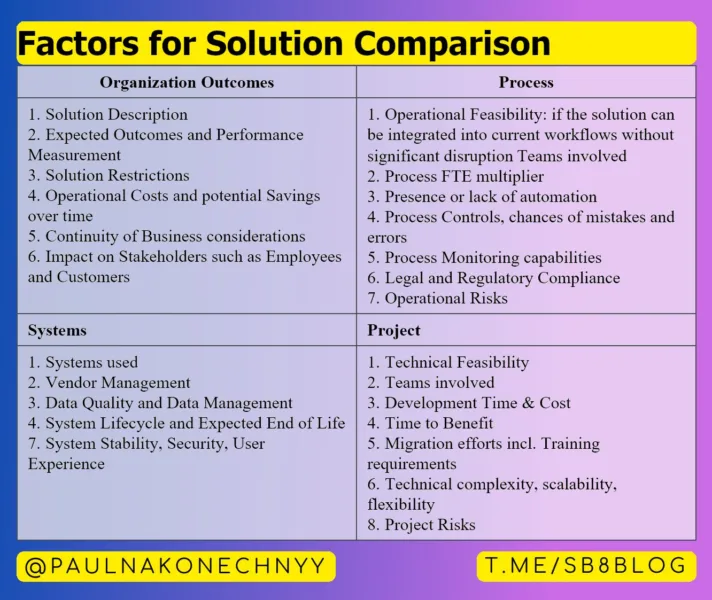Presenting Alternative Solutions to Management as an IT Business Analyst
Published by Pavel Nakonechnyy on in Business Analysis.As an IT business analyst, one of the core responsibilities is to bridge the gap between business needs and technological solutions. When faced with a problem or an opportunity for improvement, it’s crucial to present alternative solutions to management clearly and compellingly, highlighting the one you see best. A well-structured framework can make this communication more effective, ensuring that your recommendations are not only heard but also embraced. This blog post outlines a practical framework for presenting alternative solutions to management.
1. Define the Problem and Write the Problem Statement
Before proposing any solutions, it is essential to articulate the problem accurately. Start by writing a clear and concise problem statement. When necessary, include scope limits and key constraints. By defining the problem clearly, you set the stage for presenting viable alternatives.
2. Perform Thorough Analysis
Once the problem is defined, analyze the factors contributing to it. Consider results of Technical Feasibility Analysis, Cost-Benefit Analysis, and Risk Assessment. This list of factors will form the backbone of your communication.
3. Develop Alternative Solutions and Present a Comparative Framework
With a clear understanding of the problem and its context, present potential solutions. To facilitate decision-making, create a comparative framework that outlines the pros and cons of each alternative solution. Your communication should include:
- Criteria for Evaluation: Define the key criteria management will use to assess each alternative (e.g., cost, time to implement, impact on existing processes).
- Summary of Findings: Provide a brief overview that highlights the strengths and weaknesses of each alternative to the evaluation criteria.
My usual format for the communication is the following table:
| Solution | A | B | C |
| <List factors> | <Explain pros and cons of solution A with regards to the factor> |
This comparative framework allows management to make informed decisions based on clear, concise information.
Here is a list of factors you may want to include in your comparison:
4. Tailor Your Presentation
When presenting to management, tailoring your approach is vital.
- Understand the preferences and priorities of your audience team. Are they more focused on cost, efficiency, governance, or innovation?
- Try to avoid technical jargon and present the information in a way that is accessible to all stakeholders.
- Encourage questions and discussions during your presentation to foster engagement and collaboration.
Tailoring your presentation can significantly enhance its effectiveness and acceptance.
5. Provide Recommendations
Finally, after presenting the alternatives, offer your recommendations based on the analysis. Justify your choice by linking it back to the organization’s goals and aligning it with the criteria established earlier. Emphasize the anticipated benefits and how the solution addresses the problem at hand.
Presenting alternative solutions to management as an IT business analyst requires a structured approach that combines thorough analysis, clear communication, and strategic recommendations. By following tips from this post, you can enhance your ability to influence decision-making and drive positive outcomes for your organization.
